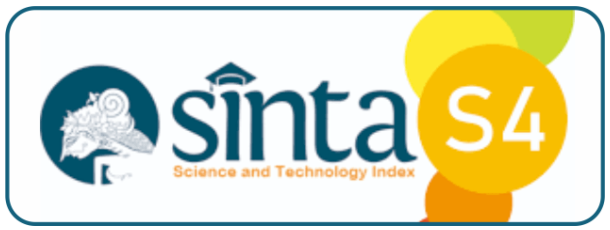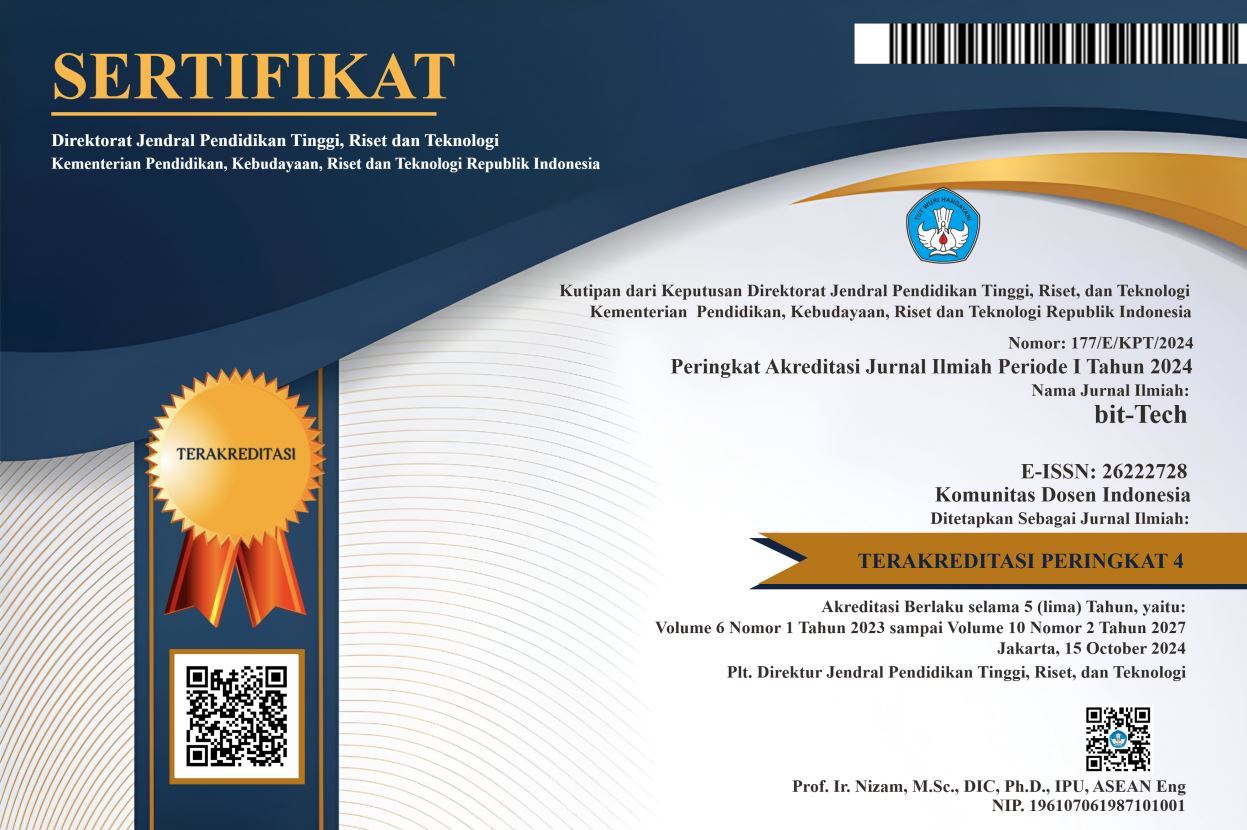Designing an Integrated Information System with a Fast and Attractive Interface to Improve Performance and User Experience
DOI:
https://doi.org/10.32877/bt.v6i3.1287
Keywords:
Attractive Interface, Integrated Information System, System Performance, User Experience, User Interface
Abstract
The Integrated Information System (Sister Fani) represents a significant innovation within the educational framework of SMK PGRI 1 Tangerang. Recognizing the imperative for a swift and engaging interface, this research endeavours to conceptualize and execute Sister Fani to adhere to elevated standards of performance and user satisfaction. Employing a qualitative methodology, data collection was facilitated through observation, interviews, and documentary research. The findings of this study underscore the pivotal role of a rapid and captivating interface design in enhancing user efficiency and enriching the overall user experience. By streamlining the process of accessing and utilizing information, the redesigned Sister Fani platform emerges as a catalyst for heightened productivity and improved service quality within the educational context of SMK PGRI 1 Tangerang. The practical implications of this research are manifold. The integration of Sister Fani into the operational framework of SMK PGRI 1 Tangerang promises to yield tangible benefits, including heightened productivity and enhanced educational service quality. By optimising the interface design to align with user expectations and requirements, educational institutions can cultivate an environment conducive to seamless information dissemination and utilisation. In conclusion, the successful implementation of Sister Fani stands poised to revolutionize the educational landscape of SMK PGRI 1 Tangerang, offering a paradigmatic shift towards efficiency, accessibility, and user-centricity.
Downloads
References
D. Kurnaedi, A. Gumiwa, and P. S. Informasi, “THE INFLUENCE OF MEDIA ON THE PROMOTION OF,” vol. 9, no. 1, pp. 79–87, 2023.
D. Kurnaedi, “Cyber School SMK PGRI 1 Kota Tangerang,” in Aplikasi Sains & Teknologi Yang Berwawasan Lingkungan Untuk Meningkatkan Daya Saing Bangsa, 2018, vol. 2018, no. September, pp. 315–327.
H. Ilham, B. Wijayanto, S. P. Rahayu, F. Teknik, and U. J. Soedirman, “ANALYSIS AND DESIGN OF USER INTERFACE / USER EXPERIENCE WITH THE DESIGN THINKING METHOD IN THE ACADEMIC INFORMATION SYSTEM OF,” J. Tek. Informtika, vol. 2, no. 1, pp. 17–26, 2021.
A. Effendi, “Jurnal Mantik Accounting Information System Effectiveness : Improvement Of Education And Training Services At Olx Autos Bandung,” J. Mantik, vol. 4, no. 36, pp. 1476-1486, 2020.
R. Abenoja, “The Experiences of Working While Studying : A Phenomenological Study of Senior High School Students,” vol. 1573, no. 082, 2019.
P. S. Negi, “Impact of Information Technology on Learning, Teaching and Human Resource Management in Educational Sector,” Int. J. Comput. Sci. Telecommun., no. July 2011, 2014.
“Optimization of Web-Based Learning Media in SMK PGRI 3 Walikukun,” no. 1, 2007.
J. R. Lewis and D. Beach, CHAPTER 38 USABILITY AND USER EXPERIENCE : DESIGN AND EVALUATION, no. September. 2023.
C. Overview, “Chapter 8-Designing the User Interface,” pp. 1-14, 2016.
F. Irianto and S. Wibowo, “ISO 9001 and IWA-2 Quality Management System in Education,” J. Educ. Innov. Curric. Dev., vol. 01, no. 02, pp. 44–49, 2023.
J. Govea, E. O. Edye, S. Revelo-tapia, and W. Villegas-ch, “Optimization and Scalability of Educational Platforms : Integration of Artificial Intelligence and Cloud Computing,” MDPI, 2023.
I. C. Igbokwe, “Application of Artificial Intelligence ( AI ) in Educational Management,” Int. J. Sci. Res. Publ., no. March, 2023, doi: 10.29322/IJSRP.13.03.2023.p13536.
U. Madako, “Digital Media and its Implication in Promoting Students ’ Autonomous Learning,” J. Pemikir. Ilm. dan Pendidik. Adm. Perkantoran, vol. 7, no. 2, pp. 319–332, 2021.
P. D. Renshaw, “Teachers using classroom data well : Identifying key features of effective practices Final report,” no. December, pp. 0–194, 2013, doi: 10.13140/2.1.1654.5600.
A. Kumar, E. Studies, R. Krishnamurthi, S. Bhatia, K. Kaushik, and E. Studies, “Blended Learning Tools and Practices : A Comprehensive Analysis,” IEEE Access, no. June, 2021, doi: 10.1109/ACCESS.2021.3085844.
A. B. Perkasa, “Teachers ’ Attitudes towards Webinars in Professional Development : A Case Study at Secondary School in Indonesia Teachers ’ Attitudes towards Webinars in Professional Development : A Case Study at Secondary School in Indonesia,” J. Innov. Educ. Cultiral Res., vol. 4, no. 2, pp. 200–208, 2023, doi: 10.46843/jiecr.v4i2.559.
A. T. C. Pratama, M A T, “Effect of User Interface and User Experience on Application Sales Effect of User Interface and User Experience on Application,” IOP, 2020, doi: 10.1088/1757-899X/879/1/012133.
W. Swasty and A. R. Adriyanto, “Does Color Matter on Web User Interface,” Commun. Inf. Technol., vol. 11, no. 1, pp. 17–24, 2017.
T. Acceptance, “Technology Acceptance and Adoption in Education ´,” Fac. Sci. Univ. Split. Split. Croat., pp. 183–197, 2023, doi: 10.1007/978-981-19-2080-6.
P. Rita, T. Oliveira, and A. Farisa, “Heliyon The impact of e-service quality and customer satisfaction on customer behaviour in online shopping,” Heliyon, vol. 5, no. August, p. e02690, 2019, doi: 10.1016/j.heliyon.2019.e02690.
A. Schmid, M. Bierschneider, J. Hoffmann, and R. Wimmer, Effects of Text Input Latency on Performance and Task Load, vol. 1, no. 1. Association for Computing Machinery, 2023.
N. Rane, A. Achari, and S. P. Choudhary, “Enhancing customer loyalty through quality of service : Effective strategies to improve customer satisfaction, experience, relationship, and engagement ENHANCING CUSTOMER LOYALTY THROUGH QUALITY OF SERVICE : EFFECTIVE STRATEGIES to CUSTOMER SAT,” IRJETS, no. May, pp. 427–452, 2023, doi: 10.56726/IRJMETS38104.
S. A. Sibagariang, F. Pohan, and M. J. Lubis, “Information and Communication Technology in the World of Education : A Theoretical and Empirical Overview – A Literature Review,” EHDJ, vol. 8, no. November, pp. 12–24, 2023.
N. R. Wiwesa, “Jurnal Sosial Humaniora Terapan USER INTERFACE DAN USER EXPERIENCE UNTUK MENGELOLA,” J. Sos. Humanipra Terap., vol. 3, no. 2, pp. 17–31, 2021.
D. Dike and L. Parida, “The micro leadership strategy of the principal to implementing character education in elementary school,” J. Prima Edukasi, vol. 8, no. 1, pp. 51-66, 2020.
H. Pratiwi, Y. Wahyuningsih, and Y. C. Oktaviani, “Jurnal Penelitian Pos dan Informatika Design and Development Archipelago Architecture Learning Media Using Qr Code Technology,” J. Penelit. Pos dan Inform., vol. 11, no. 2, pp. 191–200, 2021, doi: 10.17933/jppi.v11i2.339.
S. G. Jnanathapaswi, “Thematic Analysis & Coding : An Overview of the Qualitative Paradigm Thematic Analysis & Coding : An Overview of the Qualitative Paradigm,” APH Publ. Corp., no. December 2021, doi: 10.6084/m9.figshare.17159249.
R. Habibi, A. Glory, R. Manurung, S. Vokasi, S. Terapan, and T. Informatika, “JOURNAL OF APPLIED COMPUTER SCIENCE AND TECHNOLOGY ( JACOST ) Systematic Literature Review : Metode Penilaian Kinerja Karyawan Menggunakan Human Performance Technology,” JACOST, vol. 4, no. 2, pp. 100–107, 2023.
Downloads
Published
How to Cite
Issue
Section
License
Copyright (c) 2024 bit-Tech : Binary Digital - Technology

This work is licensed under a Creative Commons Attribution-ShareAlike 4.0 International License.
I hereby assign and transfer to bit-Tech all exclusive copyright ownership rights to the above work. This includes, but is not limited to, the right to publish, republish, downgrade, distribute, transmit, sell, or use the work and other related materials worldwide, in whole, or in part, in all languages, in electronic, printed, or any other form of media, now known or hereafter developed and reserves the right to permit or license a third party to do any of the above. I understand that this exclusive right will belong to bit-Tech from the date the article is accepted for publication. I also understand that bit-Tech, as the copyright owner, has sole authority to license and permit reproduction of the article. I understand that, except for copyright, any other proprietary rights associated with the work (e.g. patents or other rights to any process or procedure) must be retained by the author. In addition, I understand that bit-Tech permits authors to use their papers in any way permitted by the applied Creative Commons license.


 DOI :
DOI :
 Abstract views: 145
/
Abstract views: 145
/  PDF downloads: 83
PDF downloads: 83











